
The Virginia Landmarks Register (VLR) is a list of historic properties in the Commonwealth of Virginia. The state's official list of important historic sites, it was created in 1965, by the General Assembly in the Code of Virginia. The Register serves the same purpose as the National Register of Historic Places. The nomination form for any Virginia site listed on the VLR is sent forward to the National Park Service for consideration for listing on the National Register.

The Glebe House, built in 1854–1857, is a historic house with an octagon-shaped wing in Arlington County, Virginia. The Northern Virginia Conservation Trust holds a conservation easement to help protect and preserve it. The name of the house comes from the property's history as a glebe, an area of land within an ecclesiastical parish used to support a parish priest. In this case, the glebe was established by the Church of England before the American Revolutionary War.

The White House in Brentsville, Virginia was built in 1822. It was listed on the National Register of Historic Places in 1989. It is also known as the Williams-Dawe House.

Carrsbrook is a historic home and farm complex located near Charlottesville, Albemarle County, Virginia. The main house was built about 1785, and is a five-part Palladian style dwelling. It has a central, projecting 2+1⁄2-story, three-bay-wide section flanked by 1+1⁄2-story, single-bay wings connected by hyphens. The front facade features a single-story dwarf portico, supported by Doric order columns. From 1798 to 1815 the house served as the residence and school of Thomas Jefferson's ward and nephew, Peter Carr.

Cliffside is a historic home located near Scottsville, Albemarle County, Virginia. It was built in 1835, and is a two-story, brick central passage plan dwelling on a high basement in the Federal style. A side passage rear ell was added between about 1850 and 1860. Both sections have low-pitched gable roofs and the front facade features an original single-story, tetrastyle Greek Revival portico. Also on the property are a contributing structure, the "Ginger House", a one-story frame office/schoolhouse probably erected in the mid-19th century, and the family cemetery. The house served as General Philip Sheridan's headquarters during the American Civil War.

Clover Mount, also known as Tate House and Stone House Farm, is a historic home located near Greenville, Augusta County, Virginia. The house dates to the late-18th century and is a two-story, five-bay, cut limestone dwelling built in two stages and completed before 1803. The original section contained a two-room, hall-parlor plan, and measured 30 feet by 20 feet. Added to it was a single-cell, double-pile addition. A two-story stuccoed ell was added to the house around 1900. Also on the property is a contributing frame bank barn with heavy mortise-and-tenon construction.
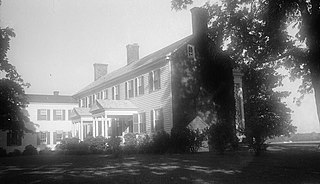
Vaucluse is a historic plantation house located near Bridgetown, Northampton County, Virginia. It is a complex, two-story, ell-shaped brick and frame structure with a gable roof. Attached to the house is a 1+1⁄2-story quarter kitchen with brick ends. The brickended section of the house was built about 1784, with the addition to the house added in 1829. The annex connecting the house with the old kitchen was probably added in 1889. It was the home of Secretary of State Abel P. Upshur (1790–1844) who died in the USS Princeton disaster of 1844. His brother U.S. Navy Commander George P. Upshur (1799–1852), owned nearby Caserta from 1836 to 1847.

Evergreen, also known as Evergreen Plantation Manor House, is a historic plantation house located near Haymarket, Prince William County, Virginia. It is known for its association with Edmund Berkeley (1824-1915), one of four brothers who led the 8th Virginia Infantry during the American Civil War and who later became a local philanthropist and led many veterans' peace and commemorative activities.

Brentsville Courthouse and Jail is a historic courthouse and jail located at Brentsville, Prince William County, Virginia. The courthouse was built in 1822, and is a two-story, Federal style brick building. It features a fanlight over the main entrance, within a keyed, semicircular brick arch and an octagonal-roofed, frame-built cupola. The Brentsville Jail was built about 1820, and is located 30 yards from the courthouse. It is a well-constructed, two-story, gable roofed structure. The county seat was moved to Manassas in the 1890s to the Prince William County Courthouse and the courthouse and jail were abandoned.
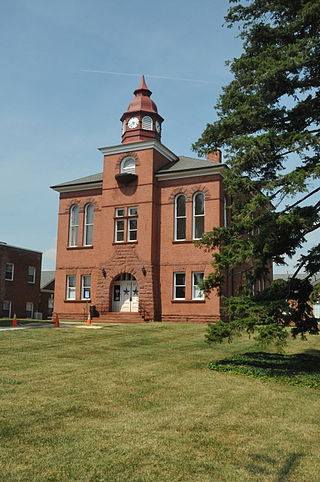
Prince William County Courthouse is a historic courthouse located at 9248 Lee Avenue, Manassas, Prince William County, Virginia. Rehabilitated in 2000–2001, it currently houses some offices of the Prince William County clerk, and the historic courtroom upstairs can be rented for events.

Ben Lomond, also known as Ben Lomond Plantation, is a historic plantation house located at Bull Run, Prince William County, Virginia. It was built in 1837, and is a two-story, five-bay, red sandstone dwelling with a gable roof. The house has a central-hall plan and one-story frame kitchen addition. One-story pedimented porches shelter the main (north) and rear (south) entries. Also on the property are the contributing frame two-story tenant's house, brick pumphouse, and a bunkhouse dated to the early 20th century; and a meat house, dairy, and slave quarters dated to the late-1830s.
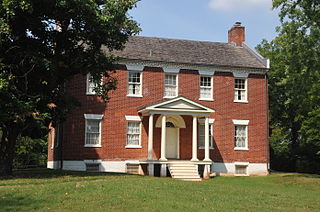
Liberia is a historic plantation house located at Manassas, Virginia, United States. It was built about 1825, and is a two-story, five-bay, Federal style brick dwelling. It has a parapet side-gable roof and a molded brick cornice with a saw-tooth design. It has a single-pile, modified central passage plan. During the American Civil War, it was used as headquarters by both Confederate and Union forces. Both Presidents Abraham Lincoln and Jefferson Davis, in addition to other statesmen, visited Liberia during the War.

The Manassas Industrial School for Colored Youth, commemorated as the Jennie Dean Memorial Site, was a former school for African-American children in Manassas, Virginia. The current site name honors the school's founder, Jennie Dean, a charismatic ex-slave who believed in the value of vocational education for African-American youth of both sexes.

Old Town Manassas, or the Manassas Historic District, is a national historic district located at Manassas, Virginia. It encompasses 206 contributing buildings and 1 contributing object in the central business district and surrounding residential area of city of Manassas.
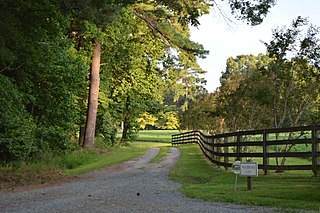
Woodford is a historic home located at Simons Corner, Richmond County, Virginia. It dates to the mid-18th century, and is a small 1+1⁄2-story, three-bay, vernacular brick dwelling. It features a clipped gable roof and exterior end chimneys. The house was restored in the 1930s. At that time, a 1+1⁄2-story frame wing and porch were added.

Fairmount School, which became known as Helen Dickinson School from 1925 until 1958 and is now the Fairmount House, is a historic school building located in Richmond, Virginia. The two-story brick building was constructed circa 1895 on a high basement in the Gothic Revival style. It features two slate-covered, mansard roofed towers. A two-story addition designed by Albert F. Huntt (1868–1920) was added in 1908–1909.

The Almshouse, also known as the City Home is a historic almshouse and hospital complex located in Richmond, Virginia.

The 2900 Block Grove Avenue Historic District is a national historic district located at Richmond, Virginia. The district encompasses five contributing buildings including three Queen Anne style houses and a square house with Mission/Spanish Revival decorative details. The houses were built between the late-1890s and 1912. Also included is a row of wooden carriage houses with cupolas and gingerbread scroll work.
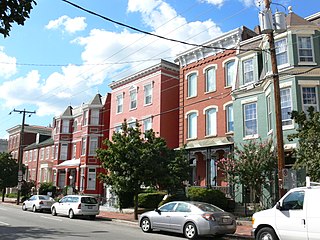
The Block 0-100 East Franklin Street Historic District is a national historic district located at Richmond, Virginia. It is located west of downtown. The district encompasses 21 contributing buildings built between about 1840 and 1920. The district is characterized by numerous mid- to late-19th century brick town houses in a variety of popular 19th-century architectural styles including Queen Anne, Italianate, and Greek Revival.

De Witt Cottage, also known as Holland Cottage and Wittenzand, is a historic home located at Virginia Beach, Virginia. It was built in 1895, and is a two-story, L-shaped oceanfront brick cottage surrounded on three sides by a one-story porch. It has Queen Anne style decorative detailing. It has a full basement and hipped roof with dormers. A second floor was added to the kitchen wing in 1917. The de Witt family continuously occupied the house as a permanent residence from 1909 to 1988.

























